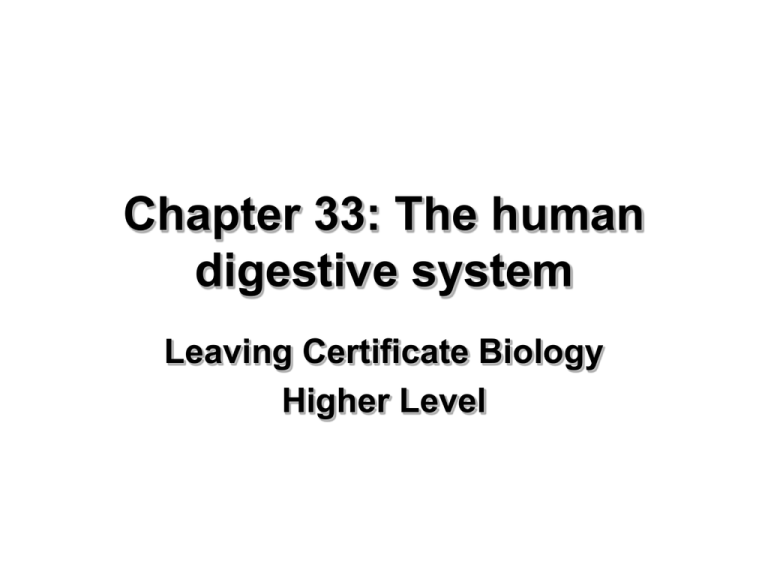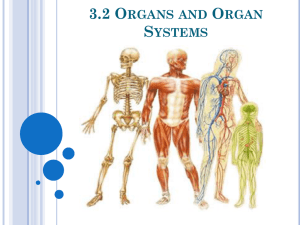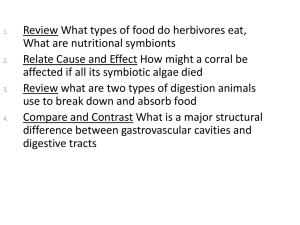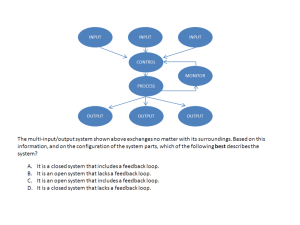
Chapter 33: The human
digestive system
Leaving Certificate Biology
Higher Level
Nutrition
• Autotrophic:
– Green plants use light
– Some photosynthetic bacteria – use light
– Some chemosynthetic bacteria – use
chemicals
• Heterotrophic:
– Organisms that have to obtain their energy
from preformed food in the environment
(animals; fungi; most bacteria)
Heterotrophic Nutrition
• Omnivore:
– Eat both plant and animal material – e.g.
human, bears, badgers
• Carnivore:
– Eat only animal material – e.g. dogs, cats
• Herbivore:
– Eat only plant material – e.g. cattle, sheep
Human Nutrition
• Digestion is the physical and chemical
breakdown of food into its constituent
molecules so that they can pass into cells
– Need for digestion in heterotrophs: they acquire
preformed food from environment. Preformed food
particles, such as carbohydrate, protein, and fats are
too big to pass directly into the body’s cells and so
must be broken down into smallest possible particles
in order to travel across cell membranes
Digestion and Digestive System
• Need for digestion and digestive system:
– Digestion: heterotrophs acquire preformed food from
environment, such as carbohydrate, protein, and fat
particles that are too big to pass directly into the
body’s cells and so must be broken down into
smallest possible particles in order to travel across
cell membranes
– Digestive system: heterotrophs have sophisticated
digestive systems that break down food particles and
are designed to extract all the nutrients from ingested
food and transport them into the bloodstream, while at
the same time ensuring that microorganisms are
killed and do not infect the body
Human Nutrition
• Ingestion: taking in of food into the mouth
• Digestion: physical and chemical breakdown of
food particles into their constituent molecules
• Absorption: constituent molecules of the food
are absorbed into cells that line the digestive
tract and transported into the bloodstream for
transport to the liver via the hepatic portal vein
• Egestion: removal of undigested and
unabsorbed material from the digestive system
Digestive
System
Anatomy
Macrostructure of Digestive System
• Mouth:
– Physical/mechanical (teeth) digestion of food
– Teeth:
•
•
•
•
•
Human dental formula: 2(I2/2; C1/1; PM2/2; M3/3)
Incisors (8 in total): cutting food
Canines (4 in total): tearing food
Premolars (8in total): grinding/crushing food
Molars (12 in total): grinding/crushing food
– Chemical digestion of food – salivary glands secrete
amylase which has an optimal pH of 7
• Starch + Amylase + pH7 → Maltose + Amylase
– Mouths forms a bolus of food that is then swallowed
Dental Decay
• Dental decay is the destruction of tooth
structure
Dental Decay
• Symptoms:
– Small holes (caries and/or cavities) appear in
the teeth – especially in areas that are difficult
to clean with a tooth brush such as the
grooved surfaces of the premolars and molars
and between the teeth
– Toothache – only occurs when the cavity has
reached the dentine and pulp areas of the
tooth where a bacterial infection of the tooth
occurs and the tooth has to be removed
Dental Decay
• Cause:
– occurs when foods containing carbohydrates (sugars
and starches) such as breads, cereals, milk, fizzy
drinks, fruits, cakes, sweets are left on the teeth
– Bacteria that live in the mouth digest these foods,
turning them into acids
– The bacteria, acid, food debris, and saliva combine to
form plaque, which clings to the teeth
– The acids in plaque dissolve the enamel surface of the
teeth, creating holes in the teeth called cavities, or
caries
Dental Decay
• Treatment:
– Depends on how bad the tooth decay is
– Use of fluoride can prevent further decay within
a cavity
– Fillings: cavities can be filled with a substances
such as metals, metal alloys, plastic, porcelain,
or a combination of materials (composite
fillings)
– Severe tooth decay may need a crown or root
canal
– Extreme tooth decay may result in the tooth
having to be removed
Dental Decay
• Prevention:
– Regular brushing (at least 2 times/day) with
fluoride toothpaste
– Regular flossing (at least daily)
– Healthy diet:
•
•
•
•
Avoid snacking on high sugar snacks
Avoid fizzy drinks and alcohol
Include foods rich in calcium and vitamin D
Chew gum after a meal
Macrostructure of Digestive
System
• Oesophagus:
– Carries food (bolus) from the mouth to the
stomach by a process called peristalsis
– Peristalsis is the rhythmical contractions of
smooth muscle of the alimentary canal that has
the effect of moving food along
• Peristalsis is also a form of mechanical digestion
• Fibre stimulates peristalsis thereby preventing
constipation
• Good movement of food along the alimentary canal
is important in decreasing the chance of contracting
colon cancer
Macrostructure of Digestive System
• Stomach:
– Receives food from mouth via oesophagus and
stores food while the cells of the gastric glands
secrete:
• HCl (parietal cells) – kills bacteria and denatures
protein
• Pepsinogen (chief cells) – is zymogen that is
activated by HCl to pepsin (optimal pH=1–2) which
then digests proteins to peptides
• Mucous (goblet cells) – is slightly alkaline and
protects the stomach lining
– Cardiac sphincter found at entrance to
stomach – opens when food enters the stomach
– Pyloric sphincter controls the amount of
chyme that leaves stomach
Stomach (Peptic) Ulcer
• A peptic ulcer is a small lesion in the
lining of the stomach wall
• A duodenal ulcer is a small lesion in the
duodenal wall
• A perforated ulcer is a complete lesion
in the wall of the stomach/duodenum
where the contents can leak into the
body cavity
Stomach (Peptic) Ulcer
• Symptoms of an ulcer:
– Persistent or intermittent pain in the upper
abdomen that is relieved by eating or taking
antacids
– Vomiting
– Fatigue (due to loss of blood due to internal
bleeding)
– In the case of a perforated ulcer, internal bleeding
and bacterial infection of body cavity (possibly
fatal)
Stomach (Peptic) Ulcer
• Cause:
– Lack of mucous or excess HCl is likely to
cause peptic ulcers
– Ulcers can also be caused by the bacterium –
Helicobacter pylori – which if untreated can go
on to cause stomach cancer
– Ulcers in the digestive system are more likely
to occur in people who:
• Take anti-inflammatory drugs such as aspirin,
ibuprofen, and naproxen
• Drink alcohol
• Smoke
• Feel stressed
Stomach (Peptic) Ulcer
• Treatment:
– If bacterial, then antibiotics are administered
– If stress-related then time-out and exercise
– If diet-related, then a special diet is made out
by a dietician
– If too much acid is being produced, then
antacids are administered
– Stop smoking and/or drinking
Stomach (Peptic) Ulcer
• Prevention:
– Prevention of stomach ulcers would involve
ensuring good hygiene when preparing food to
reduce risk of bacterial infection
– Eating balanced, nutritious meals – several
small meals are generally better than 3 big
meals
– Exercise as it combats the effects of emotional
stress
– Avoid overuse of anti-inflammatory drugs
– Do not smoke
– Avoid alcohol
Macrostructure of Digestive
System
• The small intestine:
– Consists of three parts:
• Duodenum (25 cm) – digestion
• Jejunum – absorption
• Ileum – absorption
Macrostructure of Digestive
System
• Duodenum:
– Receives chyme from stomach
– Further digestion occurs
– Secretions from the pancreas (pancreatic
juice) and gall bladder (bile) are released into
duodenum
– Pancreatic amylase, lipase and bile salts are
responsible for digestion within the duodenum
Macrostructure of Digestive
System
• Pancreas:
– Secretes pancreatic juice into the duodenum
– Pancreatic juice contains:
• Sodium bicarbonate: neutralises stomach acid
• Lipase: acts on lipids and converts it into fatty
acids and glycerol (optimal pH of lipase = 7)
• Amylase: acts on starch and converts it into
maltose (optimal pH of amylase = 7)
– Starch + amylase + pH7 → maltose + amylase
Macrostructure of Digestive
System
• The liver and its functions in digestion:
– Produces bile – which is stored in gall bladder
– Bile consists of:
• Bile salts: secreted into duodenum and emulsifies
lipids
• Sodium bicarbonate: secreted into duodenum
and neutralises acidic chyme
• Bilirubin and biliverdin: breakdown products of
haem from the haemoglobin of red blood cells
Macrostructure of Digestive System
• The liver and its other functions:
– Receives blood from the jejunum and ileum (hepatic
portal vein) – detoxifies toxins (e.g. alcohol)
– Breaks down excess amino acids into urea – which
is then excreted via the kidneys
– Converts excess glucose to glycogen which it then
stores
– Stores fat-soluble vitamin (A, D, E, and K) and trace
minerals (iron, copper, zinc)
– Synthesises clotting factors (e.g. fibrinogen)
– Synthesises cholesterol – key component of cell
membranes
Macrostructure of Digestive
System
• Jejunum and ileum:
– Absorption of nutrient occurs in this 6 m
section of the small intestine
• Monosaccharides (breakdown products of starch):
glucose, fructose, galactose are absorbed directly
into bloodstream as they are water-soluble
• Amino acids (breakdown products of protein) are
also absorbed into bloodstream as they are watersoluble
• Fatty acids and glycerol (breakdown products of
starch) are absorbed into the lacteals and combine
with proteins to form lipoproteins which are then
transported in the lymph to the blood
Macrostructure of Digestive
System
• Small intestine:
– Small intestine is very well-adapted for
digestion and absorption due to:
• Length of small intestine (6–7 m long)
• Internal epithelium is structured into villi and
microvilli to increase the surface area for
absorption
• The surface of the villi are only one-cell thick in
order that absorption into the bloodstream and
lacteals is very rapid
• Small intestine has a very good blood supply
Macrostructure of Digestive
System
• Large intestine:
– The large intestine is 1.5 m long and consists
of:
• Caecum
• Colon
• Rectum
Macrostructure of Digestive
System
• Caecum:
– Separated from the ileum by the ileocaecal
valve
– It is the beginning of the large intestine
– In humans, the caecum's main functions are
to absorb fluids and salts that remain after
completion of intestinal digestion and
absorption and to mix its contents with
mucous
Macrostructure of Digestive
System
• Appendix:
– The appendix is a small branch of the caecum
– Its average length is 10 cm
– The appendix is rich in infection fighting cell
(white cells) – suggesting that it may have an
immune function
– However, the appendix has no function
officially
Appendicitis
• Appendicitis is painful inflammation and
swelling of the appendix
• Symptoms:
– Severe and localised pain in the right, lower abdomen
• Cause:
– Bacterial growth and build up of toxins and waste
products
• Treatment:
– Surgical removal of the entire appendix
• Prevention:
– No known preventative measure
Macrostructure of Digestive
System
• Colon:
– The colon consists of three parts:
• Ascending, transverse, and descending colons
– The function of the colon is to absorb water
converting the semi-solid waste that changes into
faeces
– The colour of faeces is due to the bile pigments –
bilirubin and biliverdin
– Symbiotic bacteria (300 – 1000 different species of
bacteria live in the colon!) produce biotin (a B-vitamin)
and K which are then absorbed through the colon wall
– Symbiotic bacteria also help to break down unused
energy substrates such as small amounts of cellulose
Macrostructure of Digestive
System
• Importance of dietary fibre for the colon:
– Dietary fibre (also called roughage) is necessary to
keep the gut healthy by stimulating peristalsis and
ensuring that the undigested material moves along
freely without becoming stuck
– Constipation results if there is not enough fibre in the
diet
– Persistent constipation increases the risk of colon
cancer later in life as the undigested material begins
to fester due to bacterial action and toxins can build
up
Macrostructure of Digestive
System
• Rectum:
– Stores faeces as it arrives from the colon and
until it is egested from the body via the anus
– Egestion from the rectum through the anus is
not excretion as faeces is not a waste product
of metabolism – faeces is the undigested food
material
• REMEMBER: Excretion is defined as the removal
of the waste products of metabolism from the body
via the kidneys, skin, and lungs
Vitamin A Deficiency
• Symptoms:
– Night-blindness; dry, scaly skin; mental retardation;
and retarded growth in children
• Cause:
– Inadequate intake of food high in vitamin A
• Treatment:
– Increase intake of foods rich in vitamin A such as
milk, cheese, cream, liver, cod liver oil, leafy green
vegetable, carrots
• Prevention:
– Eat adequate amounts of milk, cheese, cream, leafy
green vegetables, carrots
Balanced Human Diet
• A balanced diet is one in which a
person receives all the essential
nutrients in the correct proportions to
maintain homeostasis
• A variety of foods should be include in the
diet to maintain good health
• No one group of foods should be taken in
excess
Balanced Human Diet
• An individual’s diet will depend on:
– Age: adolescents, adults and pregnant and
lactating women will require the largest
amount of nutrients
– Sex: generally males require more calories
than females (except during pregnancy and
lactation)
– Occupation: labourers will require more
calories per day than someone with a desk
job
– Activity: sports people will require many
more calories than a sedentary person
Food Pyramid
Slimming Disorders
• Anorexia nervosa:
– Psychological condition found mostly in women
– They have a perception that they are ‘fat’
– They eat very small amounts of food and go on strict
diets or even go long periods of time without eating
– Can be fatal
• Bulimia:
– Psychological condition similar to anorexia, however,
these people generally eat normally
– Difference is that bulimics will induce vomiting after a
meal
– Harder to treat as they appear normal because of
their eating patterns










